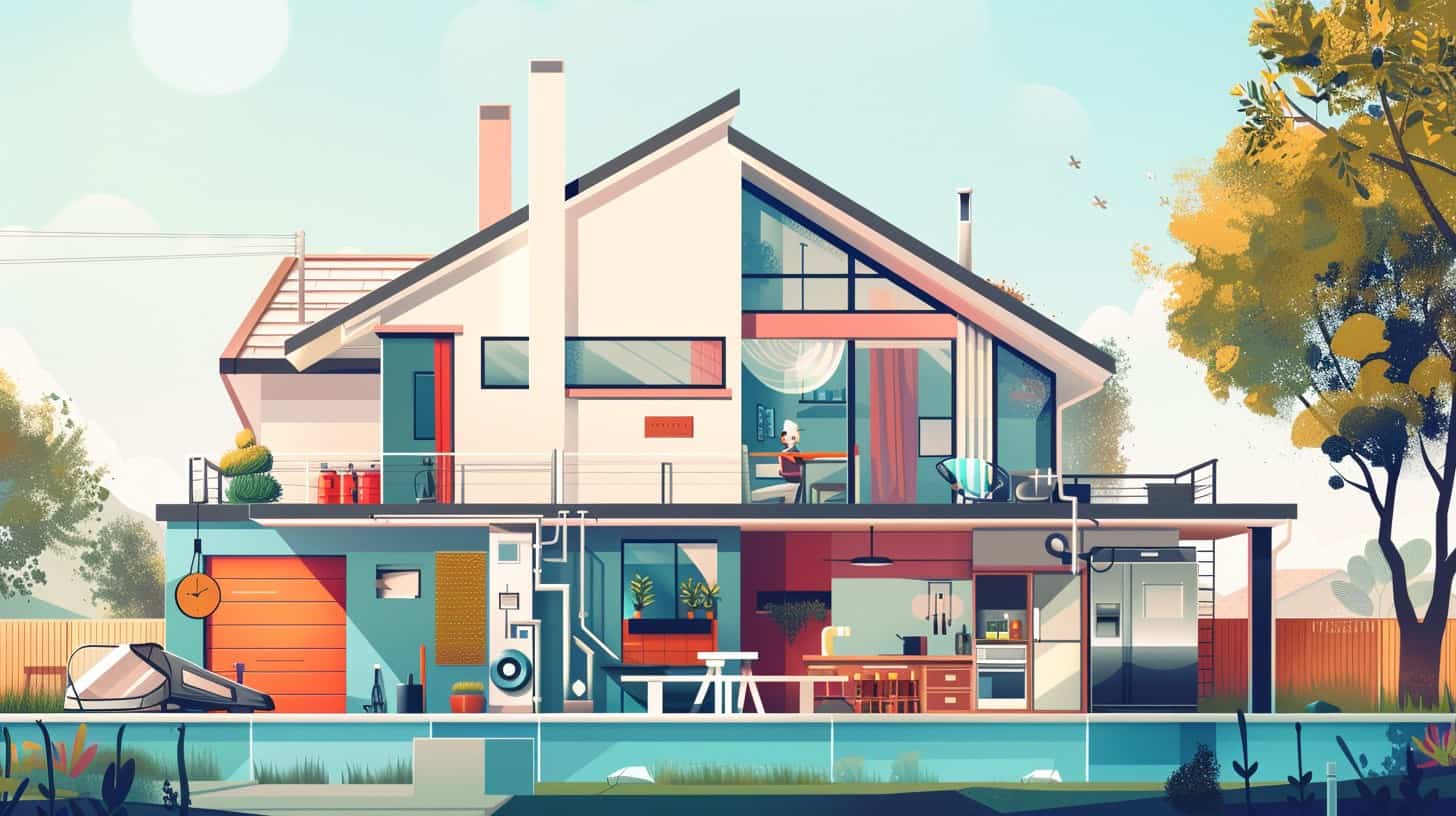Facing plumbing issues at home can feel like a real headache. Did you know, leaks waste 1 trillion gallons of water every year? This article will guide you through understanding and fixing basic plumbing problems, making your life easier.
Keep reading for hassle-free living tips.
Key Takeaways
Leaks in home plumbing systems waste 1 trillion gallons of water every year. Keeping an eye on your water meter can help catch these leaks early.
Clogs are common in both kitchen and bathroom sinks, often caused by grease in the kitchen and hair in the bathroom. Using a mix of baking soda and vinegar or a plunger can clear most clogs.
Draining your water heater twice a year prevents sediment build-up, ensuring it runs efficiently and prolongs its life.
Regular checks for leaks include looking for moisture on walls or ceilings, listening for dripping sounds, checking if pipes feel damp or warm, reading the water meter after not using water for a few hours, and watching out for sudden increases in your water bill.
Only flush toilet paper to avoid clogging pipes. Pour grease into an empty tin can instead of down the drain to prevent pipe blockages.
Table of Contents
Fundamentals of Plumbing Systems
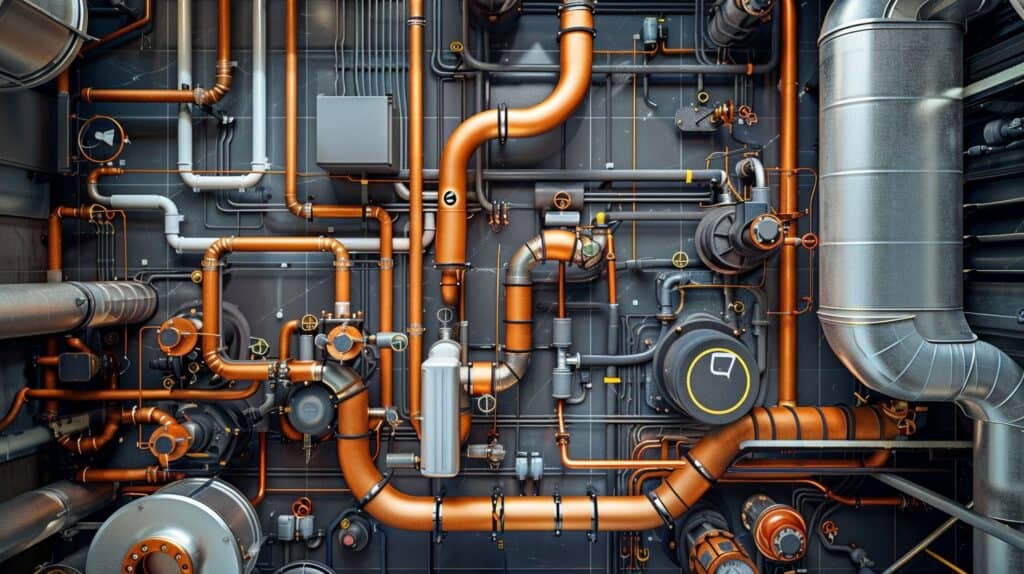
Understanding the basics of plumbing is like getting to know the veins in your house. Water comes in, gets used, and must go out through pipes, much like blood flows through our bodies.
If something blocks the flow or leaks happen, it’s time to contact an emergency plumber before your home needs a band-aid for water damage.
Overview of Water Supply
The water supply system is like the heart of your home’s plumbing, pumping clean water in so you can drink, cook, and shower. This system relies on pressure to move water through pipes from sources like wells or city reservoirs.
Think about it as a big delivery service that ensures you always have access to fresh water whenever you turn the tap.
Leaks and blockages can throw a wrench in things by causing low pressure. That means weaker showers and slow-filling pots. Every year, the US loses 1 trillion gallons of water due to leaks; that’s a lot of wasted H2O! Keeping an eye on your home’s water meter can help catch these issues early before they become bigger headaches.
Now let’s take a look at what keeps this all going down smoothly – the Drain Water Vent System.
Essentials of the Drain Water Vent (DWV) System
Drain pipes, drain traps, and vent pipes make up the DWV system. This setup uses gravity to get rid of wastewater from your house. Think of drain traps as the superheroes that keep bad smells and sewer gases out.
They’re like water-filled barriers under your sink or shower, blocking those nasty smells from coming back up the pipe.
Vent pipes play a crucial role too. They let air into your plumbing, so water can flow smoothly without any gurgling sounds or slow drains. Clogs are a big headache with this system, especially with hair in the bathroom and grease in the kitchen sinks causing trouble.
Keeping things flowing means watching what goes down those drains! Now, let’s talk about how plumbing plays out in two important rooms: the kitchen and bathroom.
Essential Components of Residential Plumbing
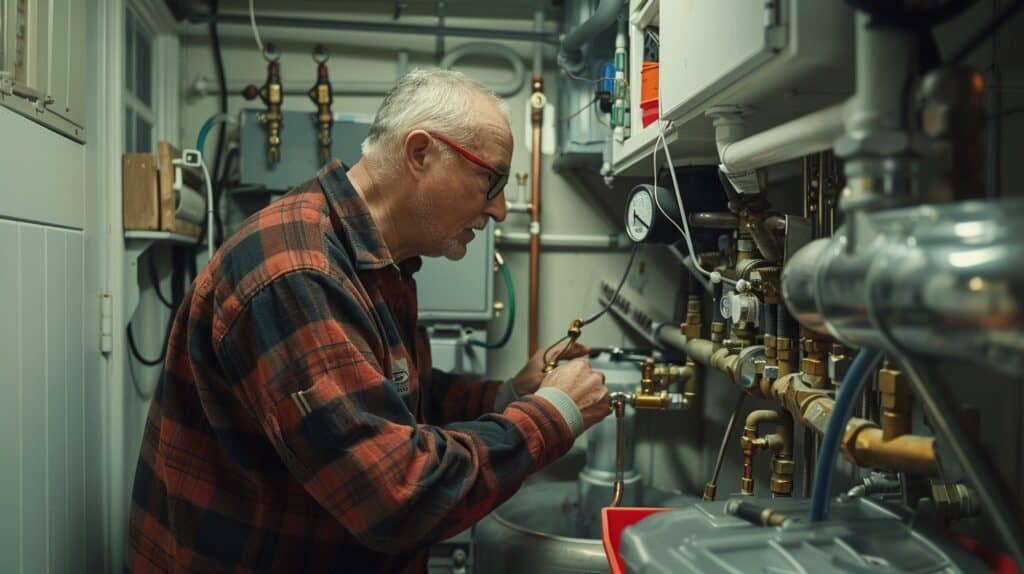
Your home’s plumbing is like the veins in your body, crucial but often hidden. From kitchens with sinks and dishwashers to bathrooms sporting showers and commodes, these systems keep water flowing where it should.
Plumbing in the Kitchen
Kitchen plumbing might seem like a maze of pipes, but it’s pretty straightforward. Pipes hidden in the walls supply both hot and cold water to your sink and dishwasher. They’re vital for making coffee in the morning or cleaning up after Taco Tuesday.
Clogs are a plumber’s nemesis, especially with grease playing the villain in kitchens. Imagine it as the bad guy blocking water’s path, causing backups where you least want them – like when you have guests over.
To fight this foe, avoid pouring oil down the drain; treat those pipes like gold.
A smooth sea never made a skilled sailor.
Now let’s dive into bathroom plumbing next, and trust me, it’s more than just flushes and faucets.
Plumbing in the Bathroom
Bathroom plumbing is a big deal. You’ve got sinks, toilets, and showers all needing clean water to work right. The water comes in so you can wash your hands, take a shower, or flush the toilet without a hitch.
But that’s not all. After you use the water, it has to go somewhere. That’s where drain pipes and vents come into play. They whisk away used water and keep everything smelling fresh.
Ever had a shower turn into a bath because the drain was clogged? Not fun. Or turned on the tap only to get more air than water? That signals trouble in paradise. Low water pressure can mean there’s something off with your pipes or valves could be leaking somewhere behind the walls—echoes of hidden issues calling for attention before they turn into major headaches.
Basic Maintenance Procedures for Plumbing

Keeping your home’s plumbing in tip-top shape is like avoiding a bad hair day; it just makes life easier. From using a drain auger to clear up the gunk, to giving those pipes and water heaters a good check-up, it’s all about keeping things flowing smoothly without any nasty surprises.
Methods for Unclogging Drains
Clogs in your drains can put a damper on your day. Before you call the professionals, try these simple yet effective ways to clear them out.
- Boil water and pour it down the drain. This might seem too easy, but often, hot water can melt away what’s blocking your pipes.
- Mix vinegar and baking soda for a fizzy clean. Pour half a cup of baking soda followed by half a cup of vinegar down the clogged drain. Wait an hour, then flush with hot water. It’s like a science project that cleans your pipes!
- Use a plunger. Make sure it’s the right kind – a flat-bottomed one is for sinks, while toilets need a bell-shaped plunger. A good plunge can make clogs history.
- Try a plumber’s snake or auger. Insert it into the drain and twist it to catch hair or other blockages. Pulling out the gunk can be oddly satisfying.
- Check the P-trap under the sink if it’s the kitchen or bathroom sink that’s giving you trouble. Put a bucket underneath to catch water and unscrew the trap—often, debris gets trapped here.
- For tougher clogs, enzyme-based cleaners are your friend—they eat through organic matter without damaging pipes. Just follow the instructions on the label carefully.
- If you have metal plumbing rather than plastic, using caustic soda (sodium hydroxide) may help dissolve clogs—just handle them with care and follow safety instructions meticulously.
- Sometimes combining methods works best; after trying chemical cleaners or natural solutions, using physical tools like plungers or snakes can clear what’s left behind.
Applying these tips should help clear the most common types of blockages in your home’s drainage system without needing to dial up professional help immediately.
Routine Checks for Pipes
Regular checks for your house’s water tubes keep things flowing smoothly. They help you spot an undetected leak before it turns into a flood story. Here’s how to do it right:
- Eyes on the Prize: Look around your home for any signs of moisture on walls or ceilings. This can mean a hidden tube is leaking.
- Listen Up: Turn off all noise-makers and listen carefully in your bathroom and kitchen. Dripping sounds could tell you there’s trouble hiding.
- Touch and Feel: Pipes often feel different when they’re not happy. A damp or unusually warm area can hint at issues inside the wall.
- Meter Check: Read your water meter, then avoid using water for a few hours. If the meter changes, you might have a leak playing hide-and-seek.
- Bill Shock: A sudden jump in your water bill can be a big red flag waving at you, saying something’s up with your pipes or drains.
Doing these checks keeps your plumbing healthy and helps avoid surprises that no one wants to come home to.
Next up: guidelines for draining water heaters to keep things hot without the meltdown.
Guidelines for Draining Water Heaters
Keeping your water heater in top shape is key. Draining it twice a year prevents plumbing mishaps and protects your home’s value. Here’s how to do it right:
- Turn off the power: For electric heaters, switch off the breaker. If you’ve got a gas model, set the thermostat to “pilot.”
- Connect a hose: Fasten a garden hose to the drain valve found at the bottom of the tank. Make sure it’s tight!
- Lead the way: Run the other end of the hose to a spot where hot water won’t cause damage or injury. Think driveway or lawn.
- Open the drain valve: Let cold water into the tank by turning on a nearby tap for venting. This helps speed up draining.
- Let it flow: Open your tank’s drain valve. Watch as sediment and water rush out through your hose.
- Flush with care: Once empty, turn on your water supply to flush out what’s left in the tank—keeping an eye on clarity.
- Fill ‘er up: Close that drain valve and detach your hose once things look clear. Fill up the tank by opening that cold-water-supply valve all anglers know and love.
- Power time: With a full tank, turn back on your electricity or gas supply and set that thermostat back from “pilot” mode.
This keeps troubles at bay and ensures hot showers stay part of your daily routine.
Moving on to checking those pipes regularly boosts peace of mind further…
Using Strainers and Enzymatic Cleaners for Pipes
After learning how to drain water heaters, it’s time to focus on keeping drains clean and clear. Strainers and enzyme-based cleaners play a big role in this task. Here’s how they work together to keep your plumbing in top shape.
- Place strainers over your bathroom and kitchen drains. These handy devices catch hair, soap bits, and food scraps before they can enter your pipes.
- Clean these strainers regularly. Just a quick rinse under the tap can prevent a mountain of problems down the road.
- For tougher clogs, turn to enzyme-based drain cleaners. Unlike harsh chemicals, these solutions use natural bacteria to eat away at blockages without damaging pipes.
- Use enzyme cleaners monthly as preventive maintenance. This keeps everything flowing smoothly and reduces the need for emergency unclogging.
- Remember, not all debris is visible. Enzyme cleaners also tackle the buildup you can’t see, keeping pipe walls clean.
- After using any cleaner, run hot water through the pipes for a few minutes. This helps flush out any loosened debris or remaining cleaning solution.
Combining strainers with enzymatic solutions offers a one-two punch against clogs and buildups in your home plumbing system.
Benefits of Consistent Plumbing Maintenance
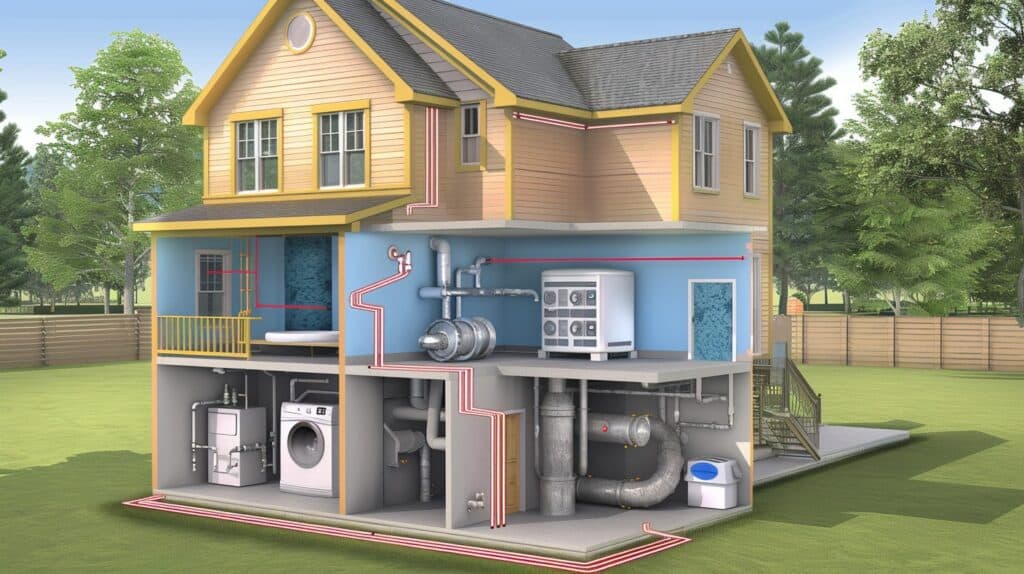
Keeping your plumbing in top shape stops big problems before they start, like leaks or clogged drains. It’s all about catching issues early and keeping everything flowing right, which saves you money and headaches.
Plus, taking care of your pipes can make things like washing dishes and taking showers better because you won’t lose pressure or have unexpected cold water surprises. Staying on top of maintenance means your home runs smoother and keeps the plumber away unless it’s necessary.
Dive deeper to learn how something as simple as regular check-ups can keep your house happy!
Preserving Optimal Water Pressure
Low water pressure is a headache nobody wants. It turns showers into trickles and fills pots at a snail’s pace. To keep the flow strong, routine checks on your pipes and taps are crucial.
Catch leaks early before they turn into floods or, worse, mold in your crawl space. Every drip counts, with plumbing leaks wasting enough water annually to fill 40 million swimming pools.
A stitch in time saves nine; the same goes for fixing leaks.
Consider this: installing efficient shower heads not only saves gallons of water but keeps the pressure up for those who can’t stand weak showers. Don’t forget to give your water heater a good flush yearly.
Sediment buildup can slow down water flow like traffic during rush hour. Use strainers over drains to prevent clogs from hair and soap chunks—they’re small changes that make big differences in maintaining steady pressure without calling the plumber every month.
Inspecting Sewer Lines
After making sure your home has great water pressure, it’s time to look at your underground plumbing. Checking sewer lines might not be anyone’s idea of fun, but it’s crucial for keeping everything flowing smoothly.
Imagine finding out too late that you have a blockage or leak – nobody wants their yard turned into a swamp.
You can use a drain snake to explore smaller issues or get professionals with cameras to take a peek inside those hidden pipes. This way, you catch problems before they blow up. It’s like being a detective but for your pipes and drains.
Keeping an eye on these could save you from the headache of big repairs down the road.
Best Practices for Disposal and Flushing
Moving from sewer checks to what goes down our drains, let’s talk trash – specifically, the kind that can clog pipes and wreak havoc on your plumbing system. Keep it simple: only flush toilet paper.
Despite labels, those so-called “flushable” wipes are no friend to your pipes or septic systems. They don’t break down like they should, leading to backups that nobody wants to deal with.
For kitchen warriors, beware of grease. It might slide off your pan easily but turns into a pipe-clogging monster once it cools down in your plumbing. Instead of washing it away with hot water (which doesn’t really fix the problem), pour it into an empty tin can, let it solidify, and then throw it in the trash where it belongs.
And for heaven’s sake, keep strainers over drains to catch food scraps and other debris that have no business going down the drain. This way, you prevent blockages and avoid the hassle of unclogging drains later on.
The Triad of Home Plumbing Systems
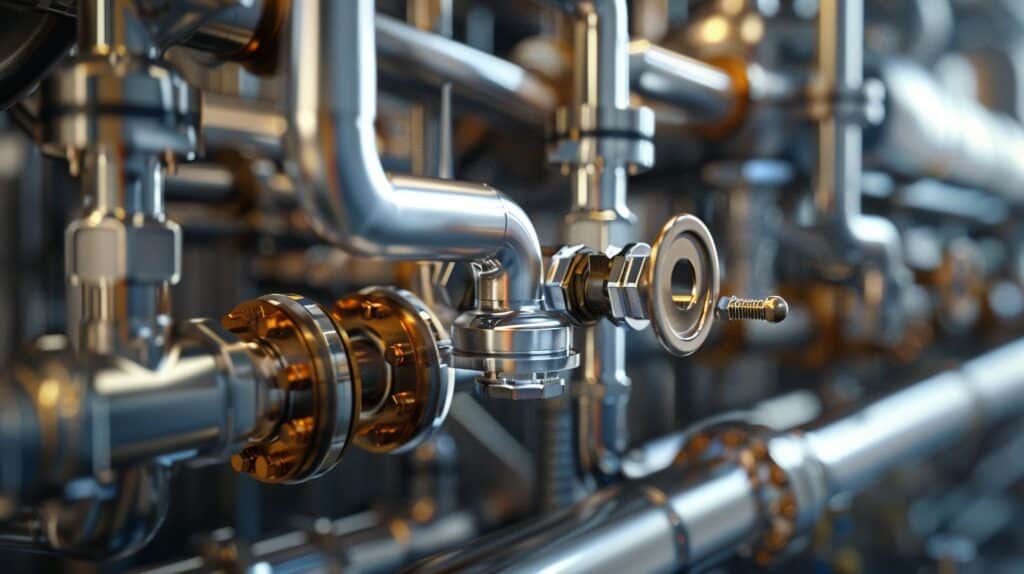
The three musketeers of your home’s plumbing are the supply, the inside flow, and the exit strategy for wastewater. Each player has its role: bringing in clean water, moving it where it needs to go without leaks or drama, and then making sure all the used water finds its way out efficiently.
Water Supply to Residences
Homes get water from two main places: city systems or private wells. City water flows through huge pipes under the streets, pushed by pressure, to reach our faucets. Well water, on the other hand, needs electric pumps to move it from underground into our homes.
Both sources aim to supply fresh and safe drinking water straight to our taps.
Fixing leaks is crucial because they waste a ton of water – think about 1 trillion gallons every year! That’s like tossing out 40 million pools worth of H2O. Plus, if there’s a problem with low pressure in your house, chances are it might be due to a sneaky leak or blockage somewhere in your system.
It’s always smart to call in a plumber for these big issues before you end up needing an entire pipe replacement job.
Water Distribution within the Home
Water makes its way to every corner of your house, thanks to a well-thought-out distribution system. This network pipes in water where you need it – from flushing toilets to filling pots in the kitchen.
Imagine opening the tap and always having safe water rush out. That’s your water distribution at work, moving supply water effortlessly behind walls and under floors.
A well-planned home is like a good plumbing system; it’s invisible but essential.
This setup splits off into various rooms, serving multiple needs. In the bathroom, it fuels showers and sinks. In the laundry room, it connects to washing machines. Even outside taps get their share for gardening or cleaning cars.
It’s all about delivering municipal water throughout your household without missing a beat – efficient and reliable with every turn of the tap or push of a button on appliances needing water heating or cold rinses.
Wastewater and Drainage Management
Managing wastewater and ensuring proper drainage keeps homes safe from the dreaded back-up horror show. It’s all about getting rid of used water without inviting any unwanted guests like mold or that stinky sewage smell.
Think of your home as a mini-water cycle system; everything that goes down must come out somewhere, right? This process relies heavily on gravity, pipes, and sometimes pumps to move water from our sinks, showers, and toilets to the outside world.
Clogs are public enemy number one in this story. They’re like the villains blocking the path of our hero—water—trying to make its grand exit. The key players fighting against these clogs include drain covers to catch hair in bathrooms and using strainers for grease in kitchens.
Regularly cleaning these guards can prevent a small issue from turning into a plumbing disaster. And let’s not forget about those heroic plumbers ready with their tools at a moment’s notice to dive deep into our pipes’ mysteries and ensure everything flows smoothly towards freedom—and away from our living spaces.
FAQs About What to Know About Plumbing
How do I keep my drains happy and unclogged?
Think of your drain like a picky eater; it doesn’t like everything. To avoid a bellyache, or in this case, a clog, skip the flushable wipes and say no to chemical drain cleaners. They’re more trouble than they’re worth.
What’s the big deal about leaks in water pipes?
Leaks are sneaky little critters that love to play hide and seek. Finding them can stop your house from turning into an indoor pool and keep mold growth at bay. Plus, you’ll save water and money – it’s a win-win!
Can preventative maintenance really save me from plumbing disasters?
Absolutely! It’s like brushing your teeth to prevent cavities but for your pipes and drains. A little TLC goes a long way in avoiding major headaches with woolf plumbing down the road.
Why should I think twice before using my toilet as a trash can?
Toilets have one job: flushing away our business, not our trash! Tossing anything other than toilet paper (yes, even those “flushable” wipes) invites trouble with blockages and could send you on an unplanned visit to meet your septic field sooner than expected.
Are energy-efficient plumbing fixtures worth the investment?
Jumping on the energy-efficient bandwagon does more than just save polar bears; it cuts down on water waste and keeps some green in your wallet too! With warranties to back them up, these fixtures are superheroes in disguise.

